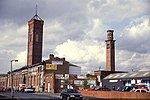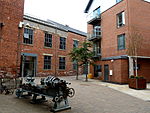Leeds Central railway station

Leeds Central railway station was a terminus railway station in Leeds, West Yorkshire, England. It was opened in 1854 as a joint station between the London and North Western Railway, the Lancashire and Yorkshire Railway, the Great Northern Railway and the North Eastern Railway. It replaced the cramped LNW terminus at Wellington Street, which had opened in 1848 with the line to Dewsbury. It closed in 1967, when its services were moved to Leeds City to consolidate all of Leeds train services in one station. The station was not architecturally distinguished and was built above street level. After closure, part of the station site became a Royal Mail sorting office, later partially redeveloped as the West Point residential development; the remaining half of the former sorting office site was to have been used for Lumiere, a 170-metre (560 ft) high skyscraper, but eventually became the site of the Central Square office development. A goods lift and a viaduct that approached the station remain extant. The last train left from Leeds Central on 29 April 1967. This was a Saturday and as there was no Sunday service, the station closed on 1 May 1967. The last train was an early evening service to Harrogate filled by the usual Birmingham RC&W DMU. Detonators were placed on the track by railway staff which exploded as the train rolled away from the platform and past the signal box on its final departure.
Excerpt from the Wikipedia article Leeds Central railway station (License: CC BY-SA 3.0, Authors, Images).Leeds Central railway station
Wellington Place, Leeds Holbeck Urban Village
Geographical coordinates (GPS) Address Nearby Places Show on map
Geographical coordinates (GPS)
| Latitude | Longitude |
|---|---|
| N 53.795785 ° | E -1.554704 ° |
Address
Wellington Place 4
LS1 4AP Leeds, Holbeck Urban Village
England, United Kingdom
Open on Google Maps









